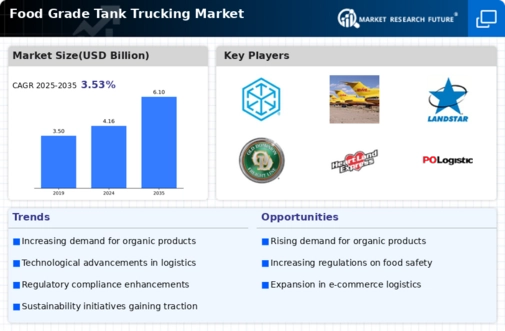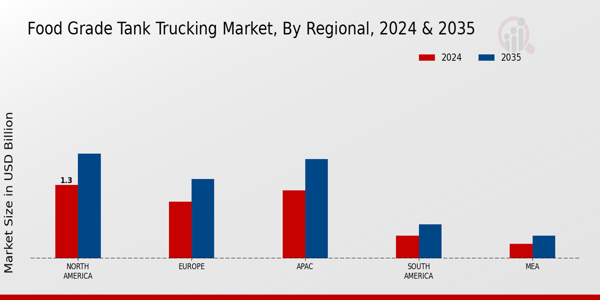Market Growth Projections
The Global Food Grade Tank Trucking Market Industry is poised for substantial growth, with projections indicating a rise from 4.16 USD Billion in 2024 to 6.1 USD Billion by 2035. This growth reflects a compound annual growth rate of 3.54% from 2025 to 2035, driven by various factors such as increasing demand for food safety, technological advancements, and the expansion of e-commerce in the food sector. The market dynamics suggest a robust future, with companies likely to invest in innovative solutions to enhance their logistics capabilities and meet the evolving needs of consumers.
Rising Demand for Food Safety
The Global Food Grade Tank Trucking Market Industry experiences a heightened demand for food safety, driven by increasing consumer awareness and regulatory standards. As foodborne illnesses pose significant health risks, stringent regulations compel food manufacturers to ensure safe transportation of products. This trend is reflected in the projected market growth, with the industry expected to reach 4.16 USD Billion in 2024. Companies are investing in advanced tank designs and monitoring technologies to comply with safety standards, thereby enhancing the reliability of food transportation. The emphasis on food safety is likely to sustain the industry's growth trajectory in the coming years.
Expansion of E-commerce in Food Sector
The expansion of e-commerce within the food sector significantly influences the Global Food Grade Tank Trucking Market Industry. As online grocery shopping gains traction, the demand for efficient and reliable food transportation solutions increases. This shift necessitates the use of food-grade tank trucks that can maintain product integrity during transit. The convenience of e-commerce is expected to drive market growth, with projections indicating a rise to 6.1 USD Billion by 2035. Companies are adapting their logistics strategies to accommodate this trend, potentially leading to innovations in tank truck design and distribution methods to meet evolving consumer preferences.
Technological Advancements in Transportation
Technological advancements play a pivotal role in shaping the Global Food Grade Tank Trucking Market Industry. Innovations such as GPS tracking, temperature control systems, and automated loading and unloading processes enhance operational efficiency and safety. These technologies not only improve the reliability of food transportation but also reduce operational costs. As the industry evolves, companies that adopt these advancements are likely to gain a competitive edge. The anticipated compound annual growth rate of 3.54% from 2025 to 2035 suggests that the integration of technology will be a key driver for sustained growth in the market.
Increasing Global Population and Urbanization
The increasing global population and urbanization trends significantly impact the Global Food Grade Tank Trucking Market Industry. As urban areas expand, the demand for food products rises, necessitating efficient transportation solutions to meet consumer needs. This demographic shift leads to a greater reliance on food-grade tank trucks to deliver perishable goods quickly and safely. The market is projected to grow substantially, reaching 4.16 USD Billion in 2024, as logistics companies adapt to the challenges posed by urbanization. The interplay between population growth and urbanization is likely to drive innovations in food transportation logistics.
Sustainability Initiatives in Food Transportation
Sustainability initiatives are increasingly influencing the Global Food Grade Tank Trucking Market Industry. As environmental concerns grow, companies are adopting eco-friendly practices in their logistics operations. This includes utilizing fuel-efficient vehicles and implementing waste reduction strategies during transportation. The shift towards sustainability not only meets regulatory requirements but also aligns with consumer preferences for environmentally responsible practices. The market's growth trajectory, projected at 6.1 USD Billion by 2035, indicates that sustainability will be a crucial factor in shaping the future of food-grade tank trucking, as companies strive to balance efficiency with environmental stewardship.




















Leave a Comment